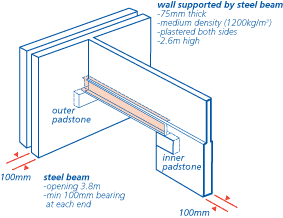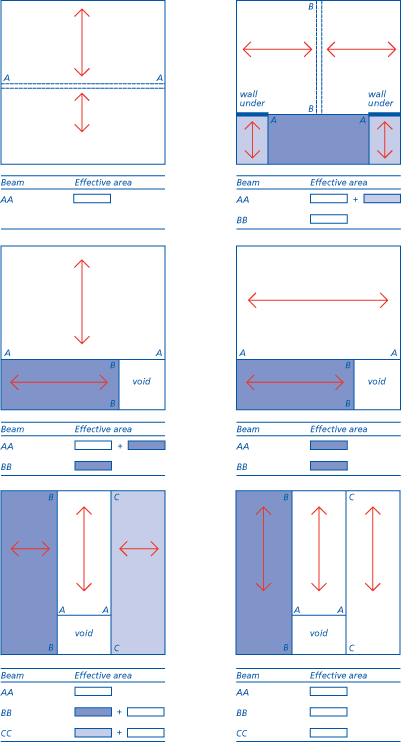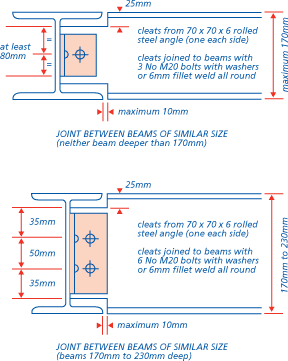6.5 Steelwork
Appendix 6.5-A
DESIGN TABLES FOR SUPPORT OF MASONRY PARTITIONS (no floor loads)
Steel beams in accordance with the Tables 1, 2 and 3 in this Appendix will be acceptable to NHBC for the support of masonry partitions, if:
- the masonry partition is not more than 2.7m in height, and
- steel beams only support the weight of the masonry partition and self weight, and
- steel beams span no more than 4.0m, and
- the masonry partition is built centrally on the steelwork beam, and
- the masonry partition is of one of the types detailed in Table 1, and
- padstones are provided, where required, and
- the masonry supporting the steel beam is of at least 2.8N/mm2 blockwork (workface size 440mm x 215mm) or brickwork and the beam supports do not occur over a door or window opening.
If any of the above limitations are not met, steelwork should be designed in accordance with Technical Requirement R5.
Method of applying tables
- Check that the situation is within all the limitations detailed above.
- Identify the masonry partition construction and thickness.
- Use Table 1 to establish the load per metre run.
- Check the span of the beam(s).
- Use Table 2 to determine a suitable steel section size.
- Check whether padstones are required - see Table 3.
(To help in applying the tables, a worked example is given at the end of this Appendix.)
Table 1 - Load of partition to be supported
| Type of masonry for supported partition (not more than 2.7m high and plastered both sides) | Maximum masonry density [kg/m3] | Structural thickness [mm] | ||
| 100 | 90 | 75 | ||
| Load [kN/m run] | ||||
| Dense masonry | 2000 | 6.8 | 6.2 | 5.4 |
| Medium masonry | 1400 | 5.1 | 4.8 | 4.2 |
| Lightweight masonry | 800 | 3.5 | 3.3 | 2.9 |
Table 2 - Size of steel beam supporting partition
| Partition load (from Table 1) [kN/m run] | Clear span of beam [m] | Smallest suitable Universal Beam size [mm x mm x kg/m] |
| Less than 3 | up to 4 over 4 | 127 x 76 x 13 see Note 2 |
| 3 to 5 | up to 3 3 to 3.5 3.5 to 4 over 4 | 127 x 76 x 13 152 x 89 x 16 178 x 102 x 19 see Note 2 |
| 5 to 7 | up to 2.5 2.5 to 3 3 to 4 over 4 | 127 x 76 x 13 152 x 89 x 16 178 x 102 x 19 see Note 2 |
Notes to Table 2
1 For spans up to 4m, Universal Column 152mm x 152mm x 23kg/m, which is the smallest size available, may be used.
2 For spans over 4m, beams should be designed by an Engineer in accordance with Technical Requirement R5.
Table 3 - Size of padstone
| Type of masonry for supported partition (not more than 2.7m high and plastered both sides) | Thickness of wall supporting beam [mm] | Minimum depth of padstone [mm] | |||||
| 100 | 125 | 140 | 150 | 190 | 215 | ||
| Min length of padstone [mm] | |||||||
| Dense masonry | 215 | 190 | 185 | 180 | 165 | 155 | 150 |
| Medium masonry | 155 | 140 | 135 | 130 | 120 | 110 | 150 |
| Lightweight masonry | 95 | 85 | 80 | 75 | 70 | 70 | 150 |
Notes to Table 3
1 Padstones are not necessary where the flange dimension of the beam exceeds the length of the padstone given in this table.
2 When steelwork is in line with the wall supporting it (ie when acting as a lintel over an opening):
- the flange dimension of the beam should not be more than 50mm greater than the thickness of the supporting wall, and
- the minimum length of padstone should be 200mm, and
- the padstone depth should match the coursing of adjacent masonry, and
- the web of the beam should be over the centre of the wall.
3 The minimum length of steel bearing onto padstone should be 100mm.
4 Padstones can be formed from:
- in-situ concrete
- precast concrete
- concrete blocks
- clay bricks.
Padstones should be formed in one unit with a minimum compressive strength of 10N/mm2.
For padstone sizes less than 215mm x 100mm, engineering bricks will be suitable.
Worked Example

Procedure
1 Using information about the supported wall and Table 1:
- load per metre run = 4.2kN/m.
2 Using the load per metre run, the span of the beam and Table 2:
- suitable section size = 178 x 102 x 19 UB (The alternative 152 x 152 x 23 UC is not suitable as it is too wide for the inner padstone/wall.)
3 Using information about the wall supporting the beam (100mm thick), the walls supported by the beam (medium density block) and Table 3:
| =155mm long |
| =150 mm deep | |
| |
| - minimum length | = 155mm |
| (as this is greater than the flange dimension of the steel section obtained in 2 above - 102mm - a padstone is required to distribute the load) | |
| - minimum depth | = 150mm |
| - thickness | = 100mm, to match blockwork |
| (The actual length and depth of a padstone could be greater to suit masonry coursing.) | |
| |
| - minimum length | = 200mm (see Note 2 to Table 3) |
| - minimum depth | = 150mm |
| - thickness | =100mm, to match blockwork. |
Beam supports should not occur above window or door openings
Appendix 6.5-B
DESIGN TABLES FOR SUPPORT OF FLOORS (no masonry partition loads)
Limitations
Steel beams in accordance with Tables 4 and 5 in this Appendix will be acceptable to NHBC for the support of floors, if:
- the floor construction is of decking (softwood boarding, chipboard, oriented strand board or plywood) on timber joists with a plasterboard ceiling underneath which is given either a plaster skim coat or a plastic finish (Artex or similar), and
- allowance has been made of 0.5kN/m2 for self weight (floor and ceiling load) and
- the floor does not support masonry partitions, and
- any lightweight partition (such as plasterboard on timber studwork or proprietary product) is non-loadbearing, and
- padstones are provided, where required, and
- clear span of beam does not exceed 4.4m, and
- connections between steelwork beams are in accordance with Appendix 6.5-C or are designed by an Engineer, and
- the floor support is one of the methods shown in Figure 1.
If any of the above limitations are not met, steelwork should be designed by an Engineer in accordance with Technical Requirement R5.
Method of applying tables
1 Check that the situation is within all the limitations detailed above.
2 Using Figure 1, determine the area supported by the beam(s).
3 Check the span of the beam(s).
4 Use Table 4 to determine a suitable steel section size.
5 Check whether padstones are required by Table 5.
6 If steel beam-to-steel beam connections are required, use Appendix 6.5-C.
Figure 1 - Effective areas supported by steel beams
If any area shown as 'void' contains a staircase, add 2m2 to the effective area supported by any beam which supports (partially or fully) that staircase.
Table 4 - Size of steel beam supporting floor
| Effective area supported (m2) | Effective trimmer span = clear span + 100mm (m) | Smallest suitable steel section size (mm x mm x kg/m) | |
| Universal beam | Universal column | ||
| 0 to 20 | 0 to 2.0 | 127 x 76 x 13 | 152 x 152 x 23 |
| 0 to 20 20 to 30 | 2 to 2.5 | 127 x 76 x 13 152 x 89 x 16 | 152 x 152 x 23 152 x 152 x 23 |
| 0 to 10 10 to 20 20 to 30 | 2.5 to 3 | 127 x 76 x 13 152 x 89 x 16 178 x 102 x 19 | 152 x 152 x 23 152 x 152 x 23 152 x 152 x 23 |
| 0 to 10 10 to 30 30 to 40 | 3 to 3.5 | 127 x 76 x 13 178 x 102 x 19 203 x 133 x 25 | 152 x 152 x 23 152 x 152 x 23 152 x 152 x 30 |
| 0 to 10 10 to 20 20 to 30 30 to 40 40 to 50 | 3.5 to 4 | 152 x 89 x 16 178 x 102 x 19 203 x 102 x 23 203 x 102 x 30 see Note 1 | 152 x 152 x 23 152 x 152 x 23 152 x 152 x 23 152 x 152 x 30 152 x 152 x 37 |
| 0 to 10 10 to 20 20 to 30 30 to 40 40 to 50 | 4 to 4.5 | 203 x 102 x 23 203 x 133 x 25 203 x 133 x 30 see Note 1 see Note 1 | 152 x 152 x 23 152 x 152 x 23 152 x 152 x 30 152 x 152 x 37 203 x 203 x 46 |
Note to Table 4
1 Beams should be designed by an Engineer in accordance with Technical Requirement R5.
Table 5 - Size of padstone
| Effective area supported (as used in Table 4) [m2] | Minimum padstone size [mm] | |||||
| Thickness of wall supporting steel beam [mm] | ||||||
| Up to 105 | 105 to 155 | 156 to 216 | ||||
| length | depth | length | depth | length | depth | |
| Up to 10 | 95 | 150 | 80 | 150 | 70 | 150 |
| 10 to 20 | 185 | 150 | 160 | 150 | 140 | 150 |
| 20 to 30 | 275 | 150 | 240 | 150 | 210 | 150 |
| 30 to 40 | 365 | 215 | 320 | 150 | 280 | 150 |
| 40 to 50 | 455 | 300 | 400 | 215 | 345 | 215 |
Notes to Table 5
1 See limitations listed at the beginning of this Appendix.
2 Padstones are not necessary where the flange dimension of the beam exceeds the length of the padstone given in this table.
3 Where the steelwork is in line with the wall supporting it (ie acting to form a lintel over an opening):
- the steel flange dimension should not be more than 50mm greater than the thickness of the supporting wall, and
- the minimum length of padstone should be 200mm, and
- the padstone depth should match the coursing of adjacent masonry, and
- the web of the beam should be over the centre of the wall.
4 Padstones can be formed from:
- in-situ concrete
- precast concrete
- concrete blocks
- clay bricks.
Padstones should be formed in one unit with a minimum compressive strength of 10N/mm2.
For padstone sizes less than 215mm x 100mm, engineering bricks will be suitable.
Appendix 6.5-C
Connection of beams supporting floors
The connection methods shown in this Appendix (determined using Appendix 6.5-B) are suitable for connecting steel beams used to support floor loads
Limitations
Limitations on the use of this method are:
- neither beam is to support masonry partitions, and
- both beams have been chosen from Table 4 of Appendix 6.5-B, and
- beams do not differ in depth by more than 40mm.
The following connections should be designed by an Engineer in accordance with Technical Requirement R5:
- between steel sections which differ in depth by more than 40mm, or
- between steel sections, one of which carries floor loads and one of which carries a masonry partition, or
- between steel sections which have not been derived using Appendix 6.5-B, or
- between steel sections which both carry masonry partitions.





















